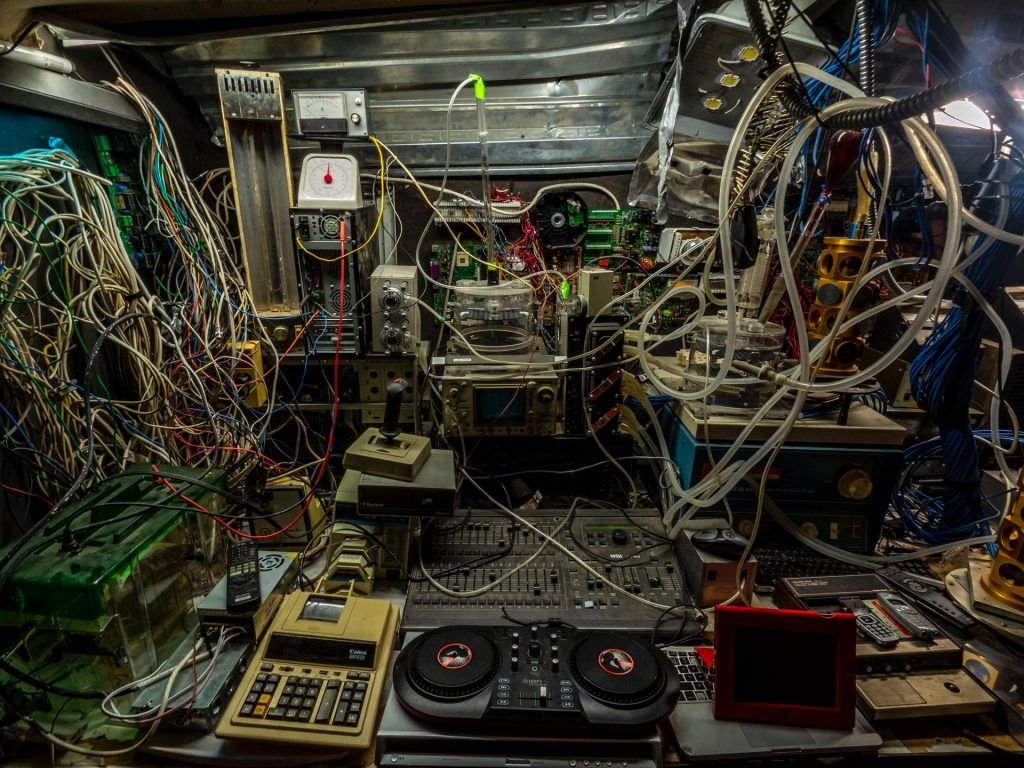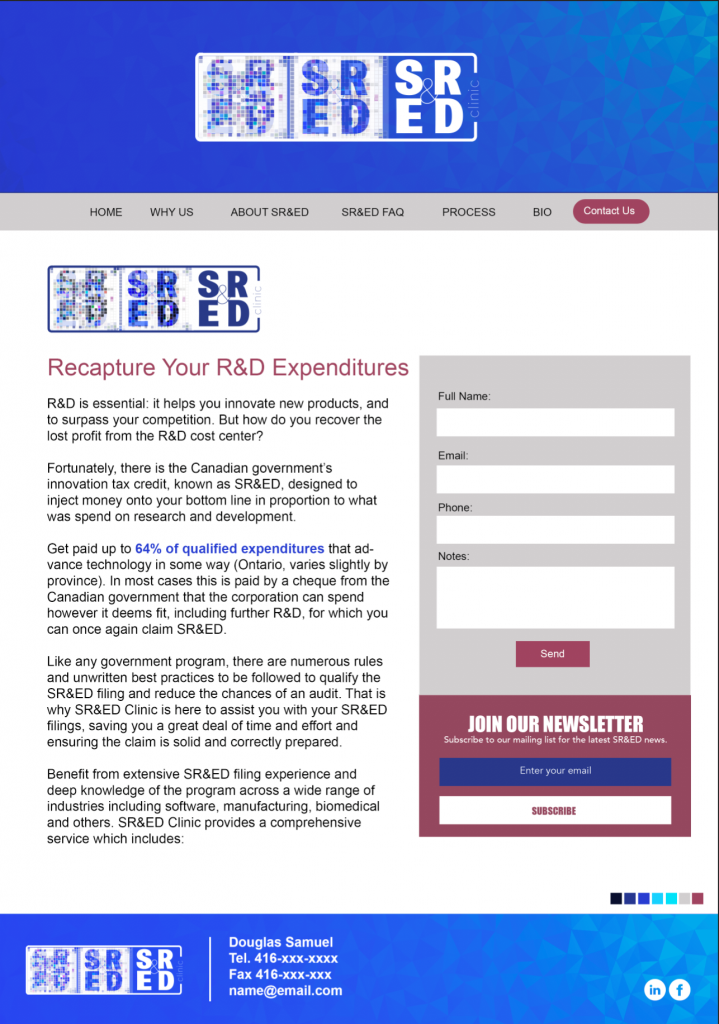
When it comes to filing SR&ED, I have noticed some common mistakes made by some of my clients, and even other SR&ED consultants. I am sharing them with you here so you can avoid them and better understand the SR&ED program and how to prepare a SR&ED claim.
Misunderstanding the program

It is impossible to file a solid SR&ED claim without understanding the SR&ED program: its purpose and rules. Some of my clients start out describing their work with “this is new to us,” “it’s never been done before” “it was R&D,” “it was all custom work” or some other similar qualifier. If this is you, don’t feel embarrassed, you’re not alone. While all of these descriptions may apply to a SR&ED project they do not in and of themselves demonstrate that the work is SR&ED.
We need to look for technical work where there is a gap between what the technology needs to be capable of to meet your needs and its current capabilities. If it has the capability, there is not SR&ED and you simply apply known principles and technologies to get the results you want. If there is a lack of technological capability in the technology you are using with no obvious way to close the gap, then the experimentation required to get to a result (or the realization that there is no solution) is probably SR&ED.
MMany comment that this seems like a high bar, but they miss the subtle areas where the technology falls short and miss the SR&ED. Many businesses are doing SR&ED without realizing that they meet the above criteria, which are actually easier to meet that you might think. You just need to understand the SR&ED program and know not only were to look, but how to look.
Project Description Misses the Point
I have read a lot of project descriptions written by others that describe the company history, the business project, why the project will impact the company or the market, revolutionize an industry, be good for the environment, and any number of other benefits. All of this is irrelevant to SR&ED. But do not despair, SR&ED-eligible projects can certainly have some or all of the above benefits.
There are only three things to focus on in a SR&ED report, and the tax form has a separate section for each:
- The technological uncertainty (or technological gap)
- The experimentation to try and overcome the technological uncertainty (or close the gap)
- The advancements – what you learned and what improved capacity, if any, your technology accrued.
I’ve seen project descriptions that boil down to “our technology needed to do X. Our hypothesis was that we could get it to do X. We were successful, and here is how it works. We advanced technology by getting X to work.”
The above SR&ED plot does not say a thing that the CRA wants to know about. They want to know what the technological gap was, why current technology was insufficient for the project requirements; they want to know the mistakes you made when you tried to close the gap; and they wanted to know what you learned including the reason certain attempts failed and what insight led to the success if you had success.
Badly Described Work

Describing the work done for a SR&ED project can be challenging even for good writers used to producing any number of useful and well written business documents. This is because the intentions of a SR&ED project description is quite different from a typical business document.
The SR&ED project description is not intended for someone else to recreate the work, learn how to use the technology, or understand how it works.
A good SR&ED description is really a litany of mistakes and what you learned from them. But not just any old type of mistake. The government will not pay you for being sloppy or ignorant! The description must be from the point of view of the failures you encountered, of the ideas that seemed solid but turned out to be wrong. They should seem perfectly reasonable to any qualified practitioner in your area of technology, it is just that when you try it, it does not work. Sometimes the failure seems kind of obvious once that you know that it did fail and why. Of course you would not have tried that idea if it really was that obviously wrong.
Sometimes the biggest challenge to writing a good SR&ED report is getting at the failures. Who wants to remember what did not work? I do not, except when I am writing SR&ED project descriptions.
Trying Random Solutions

Describing your work as trial and error is an automatic death sentence for your SR&ED claim. And yet it would seem that the very nature of experimentation is trial and error, isn’t it? CRA has their very own definition of what trial and error which you need to understand and avoid. They key to describing trial and error in a way that will not deep-six your claim is to explain why you are trying something and how the failure led to the next attempt. This can be challenging for many because although that really is they are doing, it is easy to remember the how but forget the why.
It is easy to skip over the little bit of analysis and insight that occurred just before you got the next idea. But that little bit of analysis and insight is crucial to an effective SR&ED report. Helping clients find and describe those little pieces of insight is one of the key talents a good SR&ED consultant brings to the table.
Head in the clouds (too high a level)
If the SR&ED project is discussed at too high a level, it usually leaves out the specificity required to describe the failures. I get this sometimes from the CTO. Do not get me wrong, these corporate leaders know what they are doing and they understand the technology to the level required to do their job. They know how it works, but they don’t always know how it doesn’t work, which is exactly what we need to describe for SR&ED. A high-level description of the technology often ends up being vague and lacks a description of what failed. This leads to a much higher risk of audit, and you need an audit like you need a traffic accident.
Feet in the weeds (too much detail)
Whereas explaining SR&ED at a high level often misses the point, so too does getting overly detailed. For example, you will never find SR&ED on a single line of code. The many detailed steps to prepare certain formulations may be standard and common knowledge. Put enough details together and there is SR&ED in there somewhere but do not expect the government to figure it out for you! Obvious normal steps omitted and details must be chunked up to get at the essence of what is different about the application of technology in a situation where it fails, the reasons for the failure and the possibilities to advance the technology so that it is successful. When the staff have their noses buried in the necessary details it can be hard for them to see what is really going on at a higher level, even though they are the ones making it happen. I will listen to excruciating details all day long because I know I can explain the SR&ED that comes out of those details, but such detail, other than the subtle and salient make or break points of the technological advancement usually have no place in a SR&ED report. This balance can be tricky but it is necessary to get it right so that your SR&ED filing passes smoothly.
Filing late
There are two versions of filing late, the sub-optimal kind and the fatal kind. Ideally your SR&ED claim is filed with your regular T2 tax filing within six months of the company’s financial year end. This increases the speed with which you get a refund and seems to reduce the chances of an audit.
If you do not file SR&ED when you first file your tax return, you are still OK, as long as you file withing 18 months of your financial year end. After that, your claim is permanently disqualified.
The best way to avoid being late is to file as early as possible. Be organized though the year, put the claim together starting in the last month of your fiscal period, and file your tax return along with the SR&ED portion as soon as possible.
Dragging out the process
Even if your SR&ED filing is delayed past your tax filing, once you start the process of preparing your SR&ED claim, keep at it until it is complete. I have clients that drag this process out interminably and it is painful, occasionally fatal. The painful part is everybody forgets where the SR&ED preparation process was at and it takes more time and energy to get through the next step. It also means that the preparation of one year runs into the period when the following year’s claim should be processed. Fatal is when it takes so long to prepare, that you miss the 18-month deadline, which means after a long and drawn-out preparation process, you do not even get paid.
The best way around this is to be organized through the year and start the filing process as soon as possible and do not stop until it is done.
Missing support work
Support work is work that is not in of itself SR&ED, but is required to do the experimental work required to advance your technology. Support work does not have to be explained in the project description but it does increase the size of your SR&ED claim. Many claims, especially software, are almost entirely support work. SR&ED is analyzing the problem, generating potential solutions, analyzing them to see if they might work, testing and analyzing the results to see if the approach worked. Building the solution, for example writing code or fabricating a design, is not SR&ED by itself but it is often necessary to assess your ideas. It often more time consuming that the obvious SR&ED work. Determining what is and is not support work can be tricky.
This is one area where a SR&ED consultant is especially helpful. An experienced SR&ED consultant can make educated guesses as to the sorts of support activities you may have done and forgotten about. Consultants know the rules about what types of work are qualified support and which are not.
Juicing hours
It is tempting for some to exaggerate the number of hours a SR&ED project required. The problem with this, besides being unethical, is that CRA sees many SR&ED claims across many industries and has a surprisingly good feel for how long certain types of work take, based on the project description.
I have also seen the opposite, where clients under-estimate how long something took. This is particularly common with some types of employees who are afraid the boss will think they are incompetent if something “took too long.”
There are several approaches to avoiding these problems. Instead of exaggerating hours, it is important that staff take notes as the work proceeds so they remember the details. Often people simply forget what they did, especially the slow, painful, frustrating work of trying and failing. If you can remember the failures and why they happened, SR&ED will pay you for that. SR&ED will pay you to learn something that no one else knows (but will not pay you to learn what everyone else already knows and that you could have read in a book or on the internet).
By remembering more detail, it is easy to see the hours required to do all that work and then the claim gets a lot bigger, is legitimate and can be supported in case of an audit.
Conclusion
There are a few pitfalls when preparing a SR&ED claim. Most of them can be avoided by being organized and either knowing the SR&ED rules or hiring a SR&ED consultant. Even when you hire a consultant, it is still helpful to know what works and what doesn’t so you can give the consultant what they need and make the process easier for everyone.


